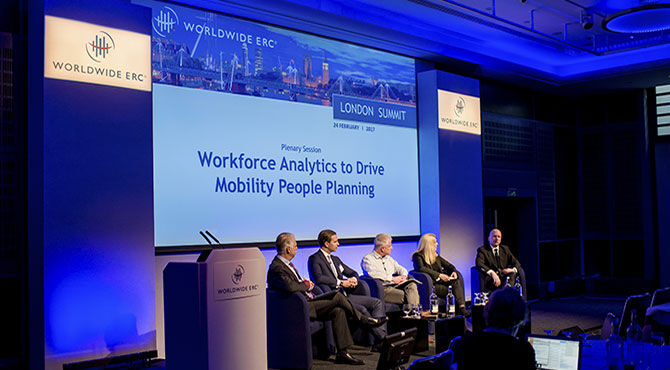A brave new world of workforce mobility data?
HR data analytics early adopters have long been voicing the benefits of corporate number-crunching. But what are the opportunities and challenges for mobility of a more strategic, data-led approach?

A mobility game changer?
Chairing the discussion, Fragomen executive director and Worldwide ERC chairman Robert J Horsley introduced the subject. He put forward the idea that workforce analytics, while highly important, were currently underused. They should have a more central role in mobility, and, when used effectively, would secure for mobility professionals greater influence, and impact more widely on business drivers and strategies.
Predicting the future
Speakers Siobhan Cummins, head of global mobility at Naspers Group, Mike Piker, vice-president of global total rewards and people technology at Naspers Group, Alain De Dauw, HR vice-president of Atlas Copco Airpower’s Airtec Division, and Gareth Paine, people analytics leader at EY, are already working in this arena.Gareth Paine supported Robert J Horsley’s view of the growing role of workforce analytics in mobility. “I think the success of the HR space is that it is catching up a lot more now and using data in their programmes to make sure there is best fit for assignments. For me, what I am seeing increasingly is companies using data to connect the dots with the best person for the right assignment at the right cost level.“Companies are using this approach to analytics in the HR and mobility space. They are extracting predictive information for different options – for example, ‘last time, you sent Joe Bloggs, and actually this other person might be a better fit and available at a lower cost’. This is where we are seeing the shift.”For Netherlands-based Siobhan Cummins, of global internet and entertainment group Naspers, the shift is due as much to resourcing. “One of the problems for mobility is that it has always been the poor relation in HR, so there has been less use of technology and a reliance on spreadsheets,” she commented.“What we are seeing now is greater use of technology that is enabling mobility to mine data and provide better analytics to the business, not only in terms of cost, but also transparency in the creation of packages, talent availability and workforce planning.”Actionable data
Offering an example of how workforce analytics were helping businesses to plan workforces and talent deployment, Naspers’ Mike Piker explained how the company approached setting up new operations from its South African base.Naspers’ data, gathered from disparate technologies, provided the company with figures on who among its 30,000 employees around the world wanted to move from the wider business and how many employees it had to hire locally. It also put vendors in the picture.“We had some really meaningful insights through the data – both lagging and predictive indicators – on how easy this would be to do and the likely success factors,” Mr Piker explained. “The landscape is very powerful now, because the data gives us discernible patterns. The time is right for change.“The technology is there. Our customers are demanding we step up and have these conversations. We can do some really meaningful things with the predictive analysis.”Capturing data and insights
For companies looking to adopt a more predictive data-led approach, Alain De Dauw, of industrial tool manufacturer Atlas Copco, observed how much data was now available at the touch of a button, and commented on the issues this could present.“Mobility is very good at producing data,” he said. “The key issue is actually how to consume it, how confident we are in making decisions based around it. How do we transform data into information and actionable insights through smart analytics and dialogue?“At Atlas Copco, we are in the middle of a transition, going from a decentralised model of data management to a global HR information system, or HRIS. What we are trying to do is transform that data into information we can use at management level.”Related articles:
- Relocate Awards 2016: Technological Innovation – Going-there Global Destination Services
- Cartus survey offers insight into 2017’s mobility landscape
- Technology for global mobility – What’s new?
Integrating systems and dialogues
Having data that is integrated – not data that sits siloed in one place – is key to driving the discussion and business preparedness, suggested discussion chair Robert J Horsley.Integrated data is the right ‘ecosystem’ for information sharing and a willingness to collaborate. From a corporate point of view, data protection and employee confidentiality can also easily be maintained, and integration offers a more efficient way of sharing and mining data.In practice, especially in the early stages of data transformation in mobility, there are challenges to establishing this. “I think when you move from a corporate to a global view, it is a challenge,” noted Alan De Dauw. “What we see is that the data that should be available is not always available. There is also a lot of reporting, and it’s a question of using the right data.”Gareth Paine agreed that, rather than having too little data, companies had too much. The issue was how to consume it.The panel remarked on the insights that relatively standard, licensed HR systems already offered, and on how outsourced relocation service providers’ systems could add further details. People, too, could be data hubs in their own right.The key for mobility practitioners looking to use data to offer insights, suggested the panellists, was to keep it simple and start small. “This removes gut feel and means you can power your hunch with data. You can test outcomes and take baby steps,” advised Gareth Paine.Truth or lie?
In a world that can often seem to be based more on strongly held beliefs than unassailable facts, the ability to test assumptions becomes very powerful, especially in the context of talent. A recent Harvard Business Review piece showed that, very often, people perceived as high performers did not live up to that label when compared on output and performance measures.With the dialogue around unconscious bias and fairness another key theme, workforce analytics offer a further powerful application in the talent management and deployment arena. The panel agreed that a shift to more data-driven decision-making was to be welcomed from the perspective of diversity and equity, and in the current climate of opposing prejudice in all its forms.Being able to test gut instincts against hard facts also offered mobility new insights into long-standing issues, such as return on investment, which had arguably dropped out of the conversation, the panel suggested, as well as enabling mobility to speak the business’s language.Look out for the upcoming spring issue of Relocate magazine, which features more insight and analysis. Reserve your copy here.Access hundreds of global services and suppliers in our Online Directory Get access to our free Global Mobility Toolkit
Get access to our free Global Mobility Toolkit  © 2017. This article first appeared in the Spring 2017 edition of Relocate magazine, published by Profile Locations, Spray Hill, Hastings Road, Lamberhurst, Kent TN3 8JB. All rights reserved. This publication (or any part thereof) may not be reproduced in any form without the prior written permission of Profile Locations. Profile Locations accepts no liability for the accuracy of the contents or any opinions expressed herein.
© 2017. This article first appeared in the Spring 2017 edition of Relocate magazine, published by Profile Locations, Spray Hill, Hastings Road, Lamberhurst, Kent TN3 8JB. All rights reserved. This publication (or any part thereof) may not be reproduced in any form without the prior written permission of Profile Locations. Profile Locations accepts no liability for the accuracy of the contents or any opinions expressed herein.
































